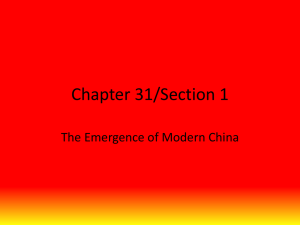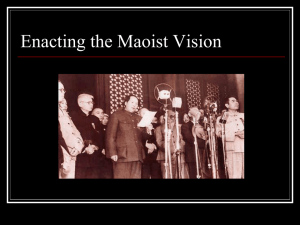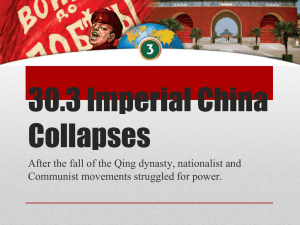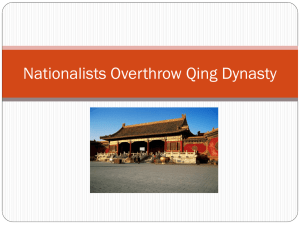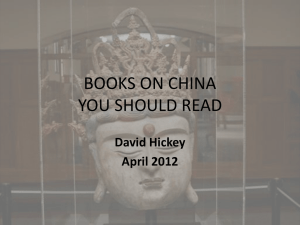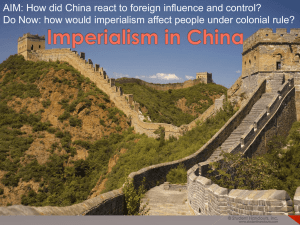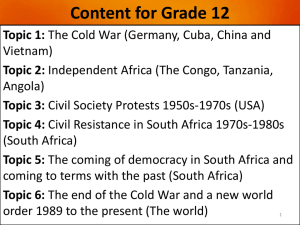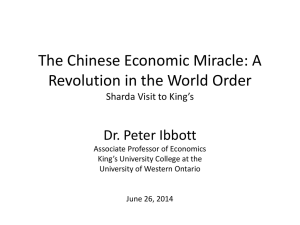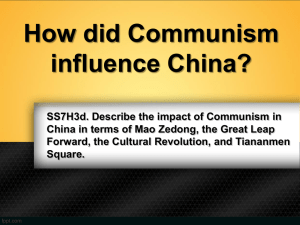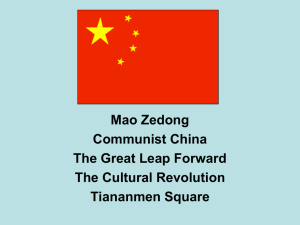Mao Zedong
advertisement
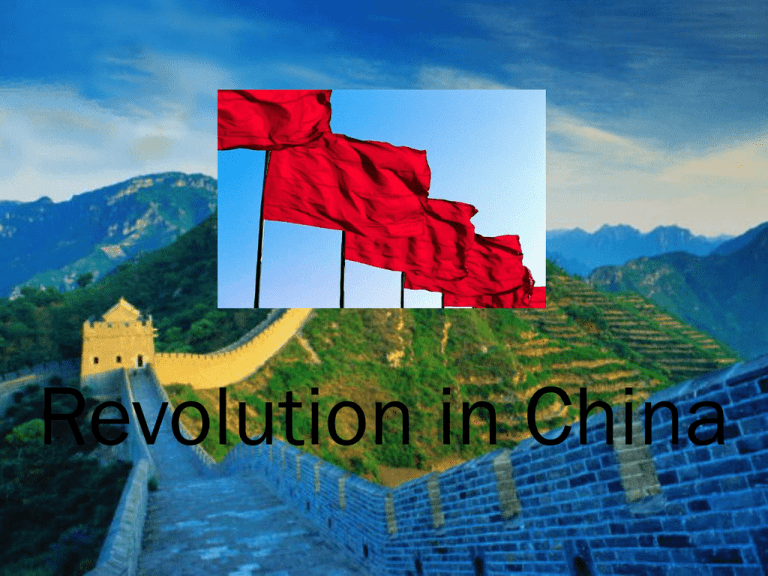
Revolution in China Problems With the Manchu Dynasty • The emperors were not strong leaders, which trickled down to other government officials, who were incompetent • Heavy taxes were put on the people • Large disparity between the rich and poor • Widespread poverty • Gov’t officials accepted money and gifts for political appointments • Foreign countries had spheres of influence where they dominated Fall of the Qing (Manchu) Dynasty • Empress Dowager Cixi (18351908) – De facto Chinese monarch (18611908) – “Make me unhappy for a day and I will make you unhappy for a lifetime.” – Conservative and anti-foreign – Blamed by many Chinese for foreign imperialist power in China Opium Wars • http://www.bbc.co.uk/history/0/20428167 • The Chinese banned opium several times, citing concern for public morals • Private British traders continued to smuggle opium into China from India • It was a way of balancing a trade deficit brought about by Britain's own addiction - to Indian tea • China's Drugs Czar Lin Tse-Hsu confiscated opium from the British traders and destroyed it • The British military response was severe, leading to the Nanking Treaty Fall of the Qing (Manchu) Dynasty • Emperor Puyi – the “Last Emperor” – Lived 1906-1967 – Ruled China 1908-1912, and as a puppet for 12 days in 1917 – Puppet emperor of Manchukuo (Japanese-ruled Manchuria), 19321945 – Spent ten years in a Soviet prison after WWII – Lived a quiet life as a regular citizen in communist China – Died of disease during the Cultural Revolution (1967) Republican Revolution (1912) • Sun Yat-sen (Sun Yixian) – Founded Kuomintang (KMT) – Nationalist party • Overthrew Manchu (Qing) dynasty • Established a republic • President of Chinese Republic who succeeded him – Yuan Shih-k’ai Kuomintang symbol Republic of China: Weaknesses • Disunity – Local warlords fought Kuomintang for control – Wars raged between 1912 and 1928 • Foreign imperialists – Americans, Europeans, and Japanese • Poor transportation – 1914 – only 6,000 miles of railroad track • 225,000 miles in the smaller United States – Few decent roads Foreign Imperialists • Twenty-One Demands (1915) – Japan attempted to make China a Japanese protectorate – Action condemned and stopped by other leading world powers • World War I and the Treaty of Versailles – China attempted to abolish concessions and extraterritoriality • Attempt failed – China did not sign the Treaty of Versailles – Japan gained mandate over most of Germany’s Asian possessions and rights Three Principles of the People • Book published by Sun Yat-sen before his death in 1925 1. Principle of Mínquán • Democracy – the people are sovereign 2. Principle of Mínzú • Nationalism – an end to foreign imperialism 3. Principle of Mínshēng • Livelihood – economic development, industrialization, land reform, and social welfare – elements of progressivism and socialism Growth of Communism • Sun Yat-sen appealed for Russian (Soviet) aid following the Versailles Conference – 1921-1925 – China received advisors, arms, communist propaganda, and loans – Russia revoked its imperialist rights in China Chinese flag, 1912-1928 The Kuomintang (KMT) is Split • Right wing – Business people – Politicians • Left wing – Communists – Intellectuals – Radicals – Students Nationalist Revolution • Sun Yat-sen succeeded by Chiang Kaishek • Communists expelled by Kuomintang • 1926-1928 – war to control the warlords • Capital moved from Peiping (a.k.a. Peking, today’s Beijing) to Nanking (Nanjing) Presidential Palace under Kuomintang Government in Nanjing Civil War in China • 1927-1932 and 1933-1937 – war between Communists and Nationalists • Communists – Mao Tse-tung (Mao Zedong) • Nationalists – Chiang Kai-shek • War halted 1932-1933 and 1937-1945 to fight Japanese aggression • Communists were victorious in 1949 • Nationalists retreated to Formosa (Taiwan) • End of imperialism in China – Hong Kong returned to China in 1997 Japanese Aggression • Japan was a threat to China – 1894-1941 • 1937 – Japanese invasion – Japanese took control of north and areas along the coast – Rape of Nanking – Chinese Communists and Nationalists • Intermittently were at peace as they united to fight against the Japanese • Guerrilla and scorched earth tactics • Received American aid against the Japanese World War II • U.S. interest in China increased after Japanese attacked Pearl Harbor in 1941 • Cairo Conference (1943) – Chiang Kai-shek met with Allied leaders – Discussed war in eastern Asia • Westerners gave up imperialist rights in China • U.S. Chinese Exclusion Act of 1882 repealed in 1943 Communists in Control – 1949 • Communists and Nationalists resumed civil war following World War II • Chiang Kai-shek’s Nationalist government wasted foreign economic aid • Many Kuomintang deserted to Communists • Manchuria – taken over by Communists in 1948 • December, 1949 -- Communists in control • Chiang Kai-shek and Nationalists retreated to Formosa (Taiwan) Geographical Changes • Communist China gained control over: – Chinese – Turkestan (Xinjiang) – Inner Mongolia – Manchuria – Tibet PRC = People’s Republic of China (Communists) / ROC = Republic of China (Nationalists) • Referred to as Chairman Mao – Chinese communist revolutionary – guerrilla warfare strategist – author – political theorist – and leader of the Chinese Revolution. – He was the architect of the People's Republic of China (PRC) from its establishment in 1949, and held authoritarian control over the nation until his death in 1976. – His theoretical contribution to Marxism-Leninism, along with his military strategies and brand of political policies, are now collectively known as Maoism. • Moved to Peking in 1918 and worked for a Marxist thinker • Quickly became a strong believer in Communism and edited radical magazines, organized trade unions, and started schools of his own. • Became one of the 50 founding members of the Chinese Communist Party • Failed in his early attempts to be a leader in the Party and his role in Party activities was decreased dramatically • Mao went back to his hometown and had very little communication with the Party • He studied the peasants and learned about their financial situation and the ways they were being abused by the landowning class • His new knowledge of the peasants allowed him to rise again as a leader in the Party, where he advocated that peasants should lead the revolution The Long March • Mao Zedong forms Communist Party and works with Nationalists • Sun Yat-Sen dies. New Nationalist leader Chaing Kai-Shek declares war on Communists • Mao and followers flee into mountains: The Long March • In mountains Mao rebuilds Communist party C. Mao Zedong- becomes leader of Chinese Communists during the “Long March” 1. advocated land reform & tax reform = gained peasant support Result: - peasants joined Communists - many join Red Army (Communist Army) - could resist Nationalists The Chinese Civil War • Fought between the Kuomintang (KMT or Chinese Nationalist Party), the governing party of the Republic of China and the Communist Party of China (CPC), for the control of China • led to China's division into two Chinas, Republic of China (now commonly known as Taiwan) and People's Republic of China (Mainland China). • The war began in April 1927, amidst The Long March and ended in 1949 (other wars like WWII were fought in between) Relationship Between Leadership and the Masses • Mao developed a program of contact with the masses that became known as the “mass line”. The process includes: – Investigating the conditions of people – Learning about and participating in their struggles – Gathering ideas from them – Creating a plan of action based on these ideas and concerns • It was a powerful tool of propaganda. By 1945, the communists had reached 100 million people and the mass line was carried to the people by 1 million members • “[A] great many so-called intellectuals are actually exceedingly unlearned . . . The knowledge of workers and peasants is sometimes greater than theirs.” • “Books cannot walk, and you can open and close a book at will; this is the easiest thing in the world to do, a great deal easier than it is for the cook to prepare a meal . . . [or] for him to slaughter a pig.” • Mao became the chairman of the Communist Central Committee • All the leaders in the party praised him and encouraged people to listen to his wisdom • In 1943, several leaders in the Party began to rewrite Chinese Party history so that Mao would be seen as responsible for all the advances of the Party • “The Chinese Communist Party takes Mao Zedong’s thought – the thought that unites Marxist-Leninist theory and the practice of the Chinese revolution – as the guide for all its work, and opposes all dogmatic or empiricist deviations.” ~Preamble to the Constitution of the Communist Party • The Communists defeated the Kuomintang and took complete control of China in 1949 • Mao’s ideas formed the basis for all Party activities and government decisions • They took control of the media and the education system and began taking land away from the wealthy and distributing it among all people Great Leap Forward • In January of 1958, five-year plan • Planned to develop agriculture and industry • Attempt to modernize China • People were forced to grow grain and melt metals down to produce steel • Led to widespread famine and death • Damaged Mao’s reputation Great Leap Backward • The entire country were forced to recycle steel, and food reserves were depleted • In some regions, after all mice, insects, and tree bark were consumed, some resulted to cannibalism • About 30 million people died, mainly due to famine • Mao needed a comeback • He organized students and mobilized them throughout the country to spread his ideas and wipe out anyone who tried to contradict him • He created an extremely effective propaganda campaign that again brought him back to power. The Cultural Revolution • 1966-1976 • Mao’s tactic to secure his power against reforms • Red Guards were formed in 1966 The Cultural Revolution • the Cultural Revolution Group directed the Red Guards to attack the 'Four Olds' of Chinese society (old customs, old culture, old habits and old ideas). • Old books and art were destroyed, museums were ransacked, and streets were renamed with new revolutionary names and adorned with pictures and the sayings of Mao • Many famous temples, shrines, and other heritage sites in Beijing were attacked and, in total, 4,922 out of 6,843 were destroyed. Cultural Rev Con’t • Forced bureaucrats, professors, technicians, intellectuals, and other nonpeasants into rural work • It is estimated that seven million were killed during the decade • China’s economy suffered Mao’s End • At the age of 82, Mao died September 9, 1976 • He died of Lou Gehrig’s disease • After his death there was a power struggle in China, but eventually moderates came to power and Mao’s regime came to an end Mao’s Legacy • Has produced great controversy • Some see him as a great revolutionary leader who made some big mistakes later in his life • Mao’s made huge mistakes such as the Great Leap Legacy Con’t • Some statistics say that the illiteracy rate and life expectancy was greatly improved while Mao was in power • It is argued that he developed them into a major world power • By abolishing prostitution, some think he improved Mao vs. Other Genocides • Murdered more people than Hitler, estimated 40 million or more Mao vs. Other Genocides • Tyrannized the world's most populous nation for more than a quarter century • Mao never really succeeded in destroying entire opposition • Mao set up a Chinese Gulag - an empire of slave labor camps filled with poorly fed "counter-revolutionaries." Mao Destruction Con’t • The majority of Mao’s killings were because of man-made famine • Mao executed nearly 10 million educated professionals, and others Political Changes under Mao • Communist government on mainland China • Mao Tse-tung (Mao Zedong) – Chairman Mao – chairman of the Communist party and leader of China – 19431976 Mao Zedong 毛泽东 Economic Changes under Mao • First Five-Year Plan (1953-1957) – Advances in agriculture and coal, electricity, iron, and steel production • Second Five-Year Plan (1958-1962) – – – – “Great Leap Forward” China became a leading industrial country Peasants organized into communes Widespread catastrophe – famine – at least 14,000,000 deaths Propaganda Poster for the Great Leap Forward Foreign Relations • Russia (Soviet Union) – Growing split between USSR and China • “Peaceful coexistence” policy of USSR viewed as surrender – 1960 – end of Soviet economic aid • Tibet – Seized in 1962 • Korea – Aided North Korea in the Korean War (1950-1953) • Vietnam – Supported North Vietnam and aided Viet Cong during Vietnam War (1959-1975) Foreign Relations • Cold War – Economic aid to Africa, Asia, and Latin America • “Atomic Club” (1964) – Fifth overall, and first non-white, country to develop nuclear weapons • United Nations – One of five permanent members of U.N. Security Council (1971, replacing Taiwan) • Relations with United States – 1972 – U.S. President Richard Nixon opened diplomatic relations with China Mao’s Little Red Book • The Chinese Communist Party is the core of the Chinese revolution, and its principles are based on Marxism-Leninism. Party criticism should be carried out within the Party. • The revolution, and the recognition of class and class struggle, are necessary for peasants and the Chinese people to overcome both domestic and foreign enemy elements. This is not a simple, clean, or quick struggle. • War is a continuation of politics, and there are at least two types: just (progressive) and unjust wars, which only serve bourgeois interests. While no one likes war, we must remain ready to wage just wars against imperialist agitations. Mao’s Little Red Book • Fighting is unpleasant, and the people of China would prefer not to do it at all. At the same time, they stand ready to wage a just struggle of selfpreservation against reactionary elements, both foreign and domestic. • China's road to modernization will be built on the principles of diligence and frugality. Nor will it be legitimate to relax if, 50 years later, modernization is realized on a mass scale. • A communist must be selfless, with the interests of the masses at heart. He must also possess a largeness of mind, as well as a practical, farsighted mindset. • Women represent a great productive force in China, and equality among the sexes is one of the goals of communism. The multiple burdens which women must shoulder are to be eased. Cultural Revolution (1966-1969) • “Great Proletarian Cultural Revolution” – Effort to revive interest in Mao’s ideas (and for Mao to regain power) after the failed Great Leap Forward – Mao claimed that reactionary bourgeoisie elements were taking over the party – Call for youths to engage in post-revolutionary class warfare – Red Guards (consisting of young people) marched throughout China – Older alleged reactionaries removed from positions of power China after Chairman Mao • Mao died in September, 1976 • “Gang of Four” – Failed at a coup d’état in October, 1976 • China continued to industrialize • One-Child Policy adopted – 1979 • Tiananmen Square Massacre – 1989 • Today – issues include: – Balancing limited capitalism with communist ideals – Environmental pollution – Unequal male-to-female ratios resulting from One-Child Policy – Control of Tibet Review Questions 1. Which group led the Republican Revolution of 1912? 2. What common enemy united the Nationalists and Communists? 3. Who led the Communist Revolution? 4. Describe the Great Leap Forward. 5. Describe the Cultural Revolution. 6. What issues face China today?
